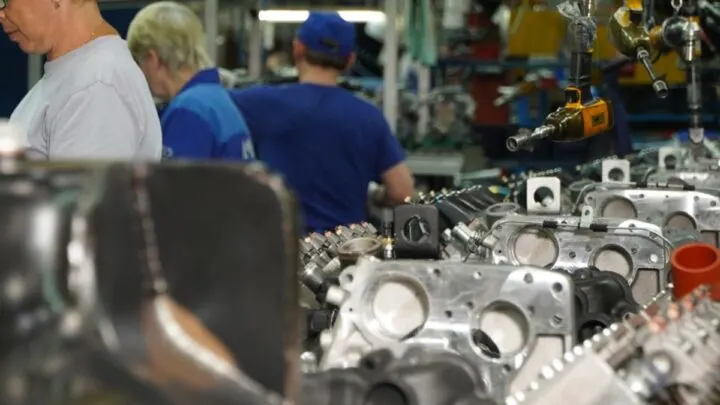Throughout history, man has been developing better and faster ways to reach their destination.
And from the wheel to steam engines, to internal combustion engines, to driver safety and assist features, the automobile world has amazing and interesting facts you ought to know.
From outright amazing to breathtaking, today’s list is all about unique and interesting facts that define the automobile world’s past, present, and future.
Let’s get started.

- The first car was made in 1769.
The first self-propelled car was developed by a relatively unknown French inventor, Nicolas-Joseph Cugnot.
The steam-powered vehicle moved at a pedestrian 2 mph and needed wood refueling every 15 minutes! For which it had to come to a complete stop.
- The first internal combustion engine car was made in 1807.
Francois Isaac de Rivaz is credited with inventing the first hydrogen-powered internal combustion engine in 1807.
Unfortunately, his idea never took off, and it wasn’t until the late 19th century that better engines became common.
- The first rechargeable electric vehicle was made in 1881.
Contrary to popular belief, the first rechargeable vehicle was made by French inventor Gustave Trouve.
In 1881, he mounted a battery and a motor on his tricycle and rode it through the streets of Paris.
- The first rechargeable American electric vehicle (EV) was made in 1890.
Iowa-based chemist William Morrison made the first rechargeable electric vehicle on American soil.
The Morrison EV was relatively pedestrian, with a maximum speed of 14 mph.
- The world’s first speeding ticket was issued in 1896.
The world’s first-ever speeding ticket was issued on January 28, 1896, in Paddock Wood, England, to Walter Arnold.
At the time, Arnold was driving at a “blistering” 8 mph, while the speed limit was 2 mph.
Coincidentally, Arnold was the son of William Arnold, the founder of Arnold Motor Carriage Company.
- America’s first speeding ticket was issued in 1904.
America’s first speeding ticket was issued in Dayton, Ohio, in 1904 to Harry Myers, who, at the time, was driving at 12 mph.
However, he wasn’t the first one to get booked for overspeeding.
Some years earlier, A New York taxicab driver, Jacob German, was cited and jailed for exceeding the 8 mph speed limit.
He was driving at 12 mph at the time of his arrest.
- The world’s most expensive speeding ticket is $1 million.
The current world record for the most expensive speed ticket fine goes to an unnamed Swedish driver. The driver was driving his Mercedes SLS AMG sports car at 180 mph (290 kph) in Sweden.
Unfortunately for the driver, the Swiss calculate the speeding fines based on a combination of one’s income and recorded speed.

- The first car accident happened in 1896.
The first automobile accident occurred on May 30, 1896, during a horseless wagon race in New York City.
Bicyclist Ebeling Thomas broke his leg after Henry Wells lost control of his vehicle and rammed into him during the race.
- The odds of dying in a car crash is 1 in 107.
If you’re afraid of driving on highways for fear of dying, then worry not, as you’re pretty safe.
According to a 2019 National Safety Council report, an individual with a driver’s license has a 0.91 percent chance of dying in a driving-related accident.
By comparison, the odds of dying by suicide is 1 in 88, succumbing to opioid overdose is 1 in 92, and slipping and dying is 1 in 106.
- The Ford Model T is the world’s first mass-produced car.
Henry Ford is acknowledged for developing the “affordable, simple to operate, and durable” Ford Model T.
Due to its mass production, the car was cheaper than the competition. You had to pay between $260 to $850 to own one.
- Almost 80 million cars are produced annually.
In 2021, 79.1 million cars were produced globally, with China being a major automobile manufacturing hub.
China produced 25.6 million vehicles, followed by Europe with 16.2 million, North America with 13.5 million, and Japan/ Korea chipping in with 10.9 million cars.
South Asia, South America, the Middle East, and Africa combined production total of 12.9 million cars.
- The United States has one-fifth of all cars on the globe.
There are about 1.4 billion cars worldwide, and an estimated 290.8 million are in the United States.
Locally, California has the highest annual car registration, followed by Texas, Florida, New York, Ohio, and Pennsylvania.
- SSC Tuatara is the world’s fastest production car.
Having the world’s fastest production car can be great for many companies, since most focus on functionality over speed.
Regardless, the SSC Tuatara is the world’s fastest street-legal car, with an outstanding top speed of 282.9 mph or 455.3 km/h.
The car has a 5.9-liter twin-turbo V8 engine that produces 1,750 horsepower, 1,341 pound-feet of torque, and 0 to 60 mph in 2.5 seconds.
- Bugatti Chiron Super Sport 300+ is the world’s fastest car.
The Bugatti Chiron Super Sport 300+ is the world’s fastest car, achieving this fête at Volkswagen’s Ehra-Lessien test track.
The car achieved a maximum speed of 304.773 mph, similar to covering 450 feet in one second!
- The man who invented cruise control was blind.
Ralph Teetor was so unimpressed by his driver’s irritating driving habits that he vowed to invent a speed control device in 1948.
While riding with his family lawyer, Teetor was unimpressed by the lawyer’s habit of slowing to speak and accelerating while listening.
- The first windshield wipers were operated by hand.
American inventor Mary Anderson is credited with developing the first operational wiper windshield in 1903.
The very “handy” windshield wiper/”window cleaning device” had a rubber squeegee blade and was operated via a hand-driven lever inside the car.

- A single car has approximately 30,000 parts.
You’ll need about 30,000 parts to assemble a car, counting every part, including bolts, nuts, and screws.
Additionally, the parts include locks, control mechanisms, door latch bits, engine components, and even sections of the infotainment system.
- The Full-Size Ford Pickup is the most stolen vehicle in the US.
We can’t ascertain why this car is quite popular with car thieves, but it is. In 2020 alone, the truck was stolen a staggering 44,014 times.
Well, maybe Ford is hiding something within this car that we don’t know.
Other highly stolen vehicles include the Chevrolet pickup truck (40,968 thefts), Honda Civic (34,144 thefts), and Honda Accord (30,814 thefts).
- 70 percent of the world’s population drive on the right side of the road.
I thought that only Americans drove on the right side of the road, but apparently, I was wrong.
There are 163 countries and regions that drive on the right compared to 76 that drive on the left.
- The average car is parked 95% of the time.
As surprising as it may be, we only use our cars to drive from one place to another, while we keep them parked most days and nights.
- There are 1.45 billion cars in the world.
There’s a car for every 7.18 people in the world! And you may be wondering where they are.
About a third of all vehicles on our roads (531 million vehicles) are in the Asia-Pacific region.
Additionally, 28 percent (405.3 million) are in Europe, and 24 percent (351 million) are in the United States, Canada, and Mexico.
- Toyota manufactures 23,814 new cars daily.
On its own, Toyota manufactures a staggering 15% of all cars produced daily.
That’s close to 993 vehicles every hour, or 17 every minute.
- Toyota Corolla is the world’s best-selling car.
Toyota Corolla’s reliability, durability, and value for money make it one of the best-selling cars in history.
Toyota sold a Corolla every 30 seconds in 2021.
- BMW built aircraft engines throughout the World War 2.
Before BMW ventured into making luxury cars and motorcycles, it produced aircraft engines for the German military that was at loggerheads with the French and British armies.
Their aircraft were faster and could achieve speeds of 125 mph.
- There are less than 250,000 Ferraris in the world.
As of 2019, Ferrari has made approximately 220,000 luxury cars since its start in 1947.
And given that the company sold 11,115 cars in 2021, the numbers add up to about 250,000 total-ever produced.
Having one is such a flex for a lot of people.
- Over 60% of all Rolls-Royce ever produced are still in good condition.
The popular belief, which may be a fact, that luxury cars tend to be unreliable may be misleading when talking about Rolls-Royce.
At least 60% of all Roll-Royce luxury cars produced in the company’s 120 years plus are still in good condition and roadworthy.

- The Rolls-Royce wheel logo is always upright.
Unlike wheel logos from companies such as Audi, Mercedes, and BMW, the Rolls-Royce wheel logo doesn’t rotate together with the wheel.
- The fastest wheel change without power tools is 59 seconds.
Ever had a tire burst while on the road and were left stranded? Well, contact German mechanics Marco Herzlieb, Denis Werner, Gordon Neumann, and Florian Walkenhors and get it done in an unbelievable 59.62 seconds.
- The fastest wheel change lasted a mere 1.82 seconds.
Blink, and you’ll miss the fastest four-tire change in human history.
Formula 1 race driver, Max Verstappen’s pit crew changed all four tires in just 1.82 seconds.
And since racing is about efficiency, it’s a matter of time before the time bar is even lower.
- The American Dream is the world’s longest car.
Limos generally tend to be longer, but none match the 100 feet, 15 inches long limousine dubbed “The American Dream.”
The car symbolizes opulence and features a swimming pool, a large waterbed, a bathtub, a small golf course, and a helipad.
- The lowest roadworthy vehicle is a mere 17.79 inches tall.
According to the Guinness World Records archives, the lowest roadworthy car ever produced is the Mirai.
It was created by teachers and students at The Okayama Sanyo High School in Japan.
- Nevada issued the first driverless car license.
The Nevada Department of Motor vehicles approved the first-ever car license for a self-driving test vehicle on February 15, 2012.
- The car with the highest mileage is a Volvo P1800.
77-year-old, Irv Gordon, achieved 3.25 million miles in his 1966 P1800 Volvo. That’s roughly driving 130 times in a loop along the earth’s equator!
Gordon attributed such longevity to following the manufacturer’s maintenance guidelines, keeping the car clean, and regular oil changes.
- Chevrolet made the first sports utility vehicle (SUV).
Despite a lot of confusion resulting from the generic SUV term, the Chevrolet Suburban Carryall is still widely regarded as the first of its kind.
It came out in 1935 and was iconic for the time, given it had a lot of room for cargo and passengers.
- The 1912 Cadillac Touring Edition is the first car to use an electric starter.
Before Charles F. Kettering invented the electric starter, people would usually manually crank up their cars.
The process was very tedious and dangerous, as the crank handle would sometimes kick back, leading to injuries.

- The longest traffic jam by duration happened in China.
Can you fathom spending 10 days in a traffic jam? Whether you like it or not, ongoing construction works resulted in a 10-day, 100 km traffic jam on one of China’s expressways.
The result is that they pushed the highway capacity to 60% beyond its design capability.
- The biggest traffic jam on American soil lasted 48 hours.
In November 2005, the oncoming Hurricane Rita sent chills down the spines of people living in Houston, Texas.
About 2.5 million vehicles moved away from the city, causing a major traffic jam on Interstate 45 that was as long as 100 miles (160 km).
Luckily, the hurricane’s devastating effect spared the city any major casualties.
- Over 1.8 billion tires are discarded annually.
We all know of the devastating effects of non-biodegradable rubber tires on our environment.
Therefore, it’s quite disheartening that a vast majority of the discarded 1.8 billion tires aren’t recycled.
- The word car comes from the Latin word carrum or carrus.
Many English words trace their roots to Latin words. For example, the word vehicle comes from the Latin word vehiculum.
In Latin, carrum/carrus is a four-wheeled wagon.
- It would take 59,615 days to drive to the sun at 65 mph.
Only you know how you’ll get there, but if you decide to travel to the sun in your car, be ready to cover 93 million miles.
At 65 mph, that will take you 163.3 years, or 59,615 days, or an equivalent of 1,430,769 hours.
Unfortunately, you’ll die of old age before getting there, even if nature and circumstances favor your suicidal attempt.
- Driving to the moon at 60 mph takes less than six months.
Did the voyage to the sun discourage you? Maybe? Well, an alternative is a moon.
Probably, you should aim for the stars to land on the moon.
At a slower 60 mph, you’ll take about 6 months before landing there.
- The last vehicle to have a hand crank start was the 1998 Lada Niva.
Russian automaker AvtoVAZ is known for making highly reliable vehicles that can stand any durability test.
However, their Lada Niva car has very unreliable electronics.
And that may be a reason why the company still had a hand crank start in its model late into the 20th century.
- By 1900, EVs were more on American roads than internal combustion engines.
It may come as a surprise, but by 1900, there were 1,575 electric cars.
The number dwarfs the 936 internal combustion cars and closely matches the 1,681 steam cars.
They were handy, didn’t need cranking up after every stop, and accelerated better.
- 9 out of 10 vehicles sold in Norway are electric or hybrid.
Norway is leading the world in the percentage of electric vehicles on its roads, with over 65% being purely electric (EVs).
However, the country has a small population of 5.4 million people, and hence the largest EV market remains to be China.
- The Audi logo ring symbolizes a merger.
The four Audi rings symbolize a merger between four Saxon automobile giants, Audi, DKW, Horch, and Wanderer, into Auto Union AG.
- The Mercedes-Benz Three-Pointed Star is quite powerful.
The famous Mercedes-Benz logo has changed colors from gold to white to silver, but its message still holds.
It symbolizes Daimler engines’ dominance on land, sea, and air.
- The Treaty of Versailles prompted BMW to manufacture cars.
The Treaty of Versailles prohibited all German automobile manufacturers from building aircraft and related accessories that could aid in the war.
Consequently, BMW opted to manufacture cars and produced the Dixi in 1929.
- Tesla Inc. is just 18 years old.
Tesla, Inc was founded on July 1, 2003, by Martin Eberhard and Marc Tarpenning. Many people assume that current majority owner Elon Musk is the founder, but that isn’t the case.
- Mercedes-Benz is the oldest car company.
Mercedes-Benz is the oldest car manufacturer in the world. The car company is known for making very reliable, high-performance luxury cars.
Furthermore, some of you may know them from the high-end Formula 1 cars that have won 7 Constructors’ Championship from 2014 to 2020.
- It takes 100 million lines of code to program the Bentley Bentyga.
A car you probably shouldn’t take to your local third-party repair shop is the Bentley Bentayga, owing to its long lines of code and complicated electronics.

- Toyota is the most dependable car brand.
Ever seen a rusted, old Toyota in some yard? The chances are that you’ll turn on the ignition, and it will come back to life.
Toyota cars are reliable and reach more than 200,000 miles with minor repairs and regular maintenance.
